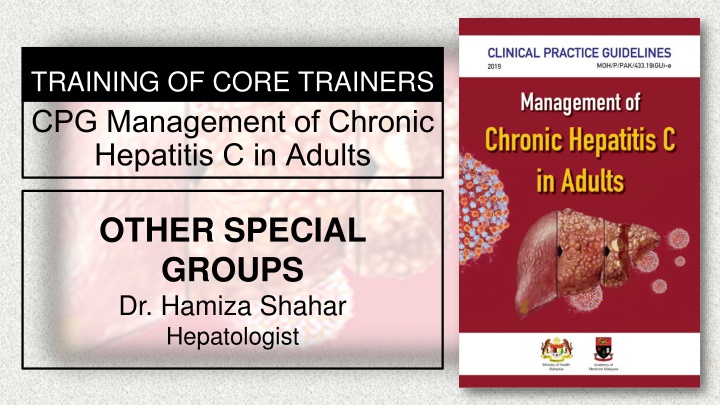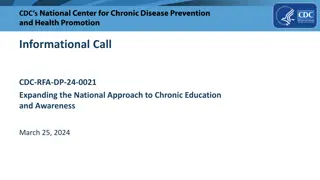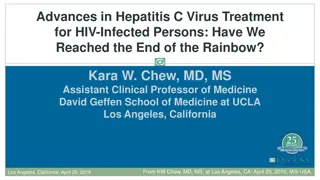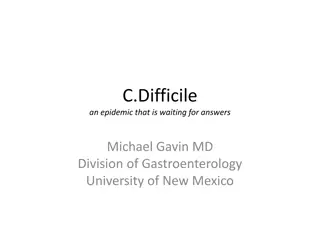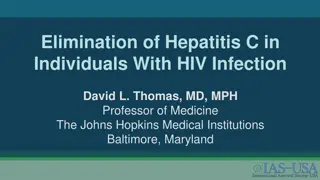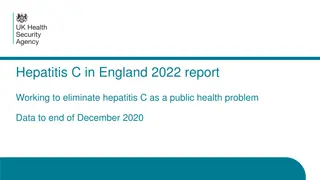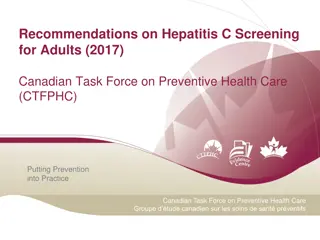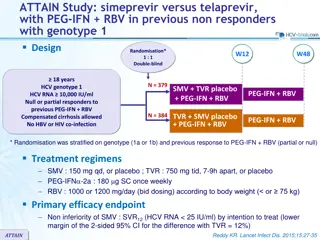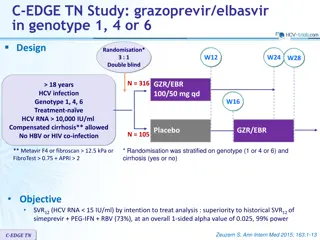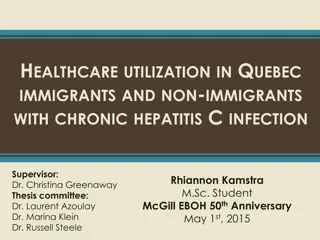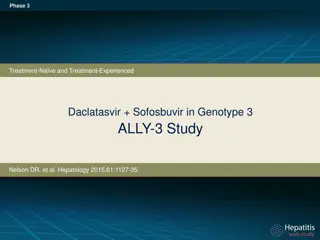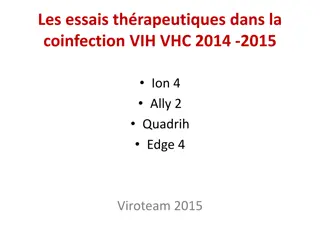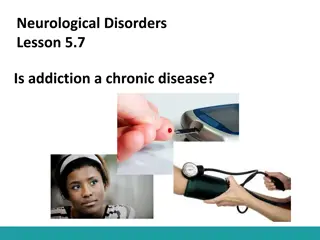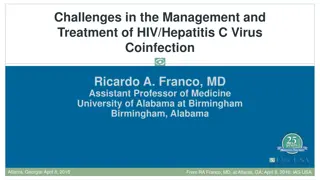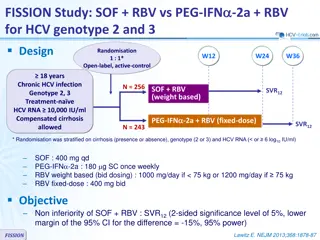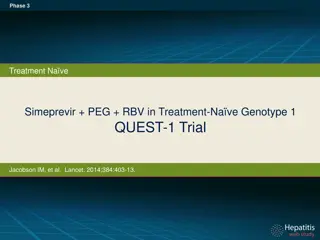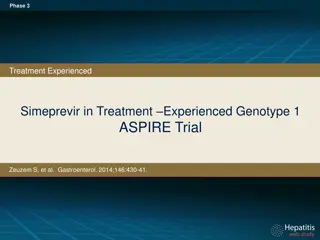Management of Chronic HCV Infection in Special Groups
Special groups such as Hepatitis B co-infection, HIV co-infection, haemoglobinopathy, and more require specific management strategies for chronic HCV infection. Learn about the implications, risks, and treatment approaches for these unique populations in this educational module presented by Dr. Hamiza Shahar, a hepatologist.
Download Presentation

Please find below an Image/Link to download the presentation.
The content on the website is provided AS IS for your information and personal use only. It may not be sold, licensed, or shared on other websites without obtaining consent from the author.If you encounter any issues during the download, it is possible that the publisher has removed the file from their server.
You are allowed to download the files provided on this website for personal or commercial use, subject to the condition that they are used lawfully. All files are the property of their respective owners.
The content on the website is provided AS IS for your information and personal use only. It may not be sold, licensed, or shared on other websites without obtaining consent from the author.
E N D
Presentation Transcript
TRAINING OF CORE TRAINERS CPG Management of Chronic Hepatitis C in Adults OTHER SPECIAL GROUPS Dr. Hamiza Shahar Hepatologist
Learning Objectives To learn about management of chronic HCV infection in adult special groups. 2
Introduction: Special Groups Hepatitis B Co-infection HIV Co-infection (Lecture 4) Haemoglobinopathy Immune-complex mediated manifestations Chronic Kidney Disease/End-Stage Renal Disease (CKD/ESKD) Pregnancy Acute hepatitis C Hepatitis C in children & adolescents 3
Hepatitis B (HBV) Co-infection HBV/HCV co-infection is more common among people who inject drugs (PWID) or in areas where these 2 viruses are endemic. Co-infection of HBV/HCV increases risk for HCC by 13.3%.46 HBV/HCV co-infected patients should be treated similar to HCV mono-infected once HBV status has been assessed. 46. Tsai JF et al. Br J Cancer. 1997;76(7):968-74. 4
Hepatitis B (HBV) Co-infection -2 Why Need to Treat? Meta-analysis of 17 cohort studies on HBV/HCV co-infection:47 When receiving DAAs treatment, HBV reactivation occurred more frequently in patients with chronic 24% [hepatitis B surface antigen (HBsAg)] than resolved 1.4% [HBsAg-negative/hepatitis B core antibody (HBcAb)-positive] infection. In chronic HBV infection, the risk of HBV-reactivation-related hepatitis was significantly lower in patients with HBV DNA below the lower limit of quantification at baseline than in those with quantifiable HBV DNA (RR=0.17, 95% CI 0.06 to 0.50). Thus, the use of antiviral prophylaxis might be warranted in HBsAg positive patients, particularly those with quantifiable HBV deoxyribonucleic acid (DNA). 47. M cke MM et al. Lancet Gastroenterol Hepatol. 2018;3(3):172-80. 5
Hepatitis B (HBV) Co-infection -3 Source: Centres for Disease Control and Prevention. Available at: https://www.cdc.gov/hepatitis/hbv/hbvfaq.htm 6
Haemoglobinopathy The prevalence of chronic HCV infection among thalassemia patients varies widely and can reach up to 85%.56 Mainly transmitted through blood transfusion before screening of blood donors was introduced.57 Among various hemoglobinopathies (mainly thalassemia major, HCV GT1b with previous PEG-IFN + RBV treatment failure & cirrhosis) using DAAs including SOF-based regimes mainly SOF + DCV & SOF + LDV RBV, high SVR12 of 93.5% had been reported, similar to patients without hemoglobinopathies.57 56. 57. Prati D et al. Blood. 1998;92(9):3460-4. Origa R et al. Am J Hematol. 2017;92(`12):1349-55. 7 7
Immune-complex Mediated Manifestations HCV patients are at risk of developing extrahepatic manifestations that include cryoglobulinaemic vasculitis (CV). Mixed cryoglobulinaemia (MC) is a clonal disorder of B cells with a strong association to HCV infection. HCV can lead to systemic vasculitis with immune complex formation and deposition. Current therapeutic approaches are aimed at elimination of HCV infection, removal of cryoglobulins and expansion of B-cell clonal. 8 8
Immune-complex Mediated Manifestations -2 Patients with HCV-associated cryoglobulinemia treated with DAAs show significant improvement in: o virological response58 o biochemical response58 - 61 o clinical response59 - 60 o immune response58 - 61 o complete response58 o model for end-stage liver disease (MELD) score59 DAAs are safe in HCV-related mixed cryoglobulinemia with mild adverse events. 58. 59. 60. 61. Lauletta G et al. Arthritis Res Ther. 2017;19(1):74. Gragnani L et al. Hepatology. 2016;64(5):1473-82. Bonacci M et al. Clin Gastroenterol Hepatol. 2017;15(4):575- 83.e1. Emery JS et al. Am J Gastroenterol. 2017;112(8):1298-308. 9
CKD/ESKD HCV infection in CKD is associated with: o increased liver-related morbidity & mortality rates o accelerated progression to ESRD o risk of cardiovascular events o increase the morbidity & mortality rates of both dialysis & kidney transplant (KT) patients 11
CKD/ESKD -2 Studies showed:63 - 64 o once-daily oral regime of GZV/EBR for 12 weeks achieved high rates of SVR 97.4 - 99% o an acceptable safety profile in patients with HCV genotype 1 infection & advanced CKD with or without dialysis Treatment with GLE/PIB for 12 weeks:65 o resulted in an SVR of 98% (95% 95 to 100) in patients with stage 4 or 5 CKD & HCV infection. 63. 64. 65. Bruchfeld A et al. Lancet Gastroenterol Hepatol 2017;2(8):585-59. Roth D et al. Lancet. 2015;386(10003):1537-45. Gane E et al. N Engl J Med. 2017;377(15):1448-55 12
CKD/ESKD -3 A meta-analysis of 21 cohort studies of moderate quality showed that:62 o regime including SOF could be proposed for HCV-infected CKD patients with or without HD o it should be associated with close clinical, biological, cardiovascular & therapeutic drug monitoring. 62. Li M et al. Virol J. 2019;16(1):34. 13
Treatment Algorithm of CKD using DAAs 14
Treatment Algorithm of CKD using DAAs -2 15
Treatment Algorithm of CKD using DAAs -3 16
Pregnancy Adapted: Kushner et al. Hepatology Communications. 2019;3(1). Treatment of hepatitis C should not be initiated until pregnancy has been excluded due to the lack of safety & efficacy data.28 28. AASLD-IDSA HCV Guidance Panel. Clin Infect Dis. 2018;67(10):1477-9 17
Pregnancy -2 Women of reproductive age with HCV should be counselled about the benefit of antiviral treatment prior to pregnancy to improve the health of the mother & eliminate the low risk of mother-to-child transmission (MTCT). Women who become pregnant while on DAA therapy (with or without ribavirin) should discuss the risks versus benefits of continuing treatment with their physicians. Ribavirin is contraindicated in pregnancy due to its known teratogenicity. In addition, the risk for teratogenicity persists for up to 6 months after ribavirin cessation & applies to women taking ribavirin & female partners of men taking ribavirin. 18
Acute Hepatitis C Most patients with acute hepatitis C are asymptomatic. Spontaneous viral clearance varies from 14% to 50%. A minimum of 6 months of monitoring for spontaneous clearance is recommended before deciding to initiate treatment . If decision is to initiate treatment during the acute infection period, HCV RNA monitoring for at least 12 to 16 weeks before starting treatment is recommended. Patients who spontaneously clear after acute hepatitis C, antiviral treatment is not recommended. Treatment recommendation is as described for chronic hepatitis C treatment.28 19
Hepatitis C in Children & Adolescents The United Nations Convention on the Rights of the Child defines a child as an individual below the age of 18 years; WHO defines an adolescent as a person between the ages of 10 & 19. Major route of infection in: o mother-to-infant transmission in children o adolescents are at risk of infection via injecting drug use. Numerous trials of PEG-IFN & RBV in children but current treatment options with DAAs are limited. The use of SOF/LDV for 12 weeks in children ages 12 - 17, weighing greater than 35 kg (genotype 1, 4, 5 and 6) have resulted in SVR rate of 98%.11,14 Combination of SOF & RBV has also been proposed for genotypes 2 & 3 for adolescents.11,14 11. 14. World Health Organization. Geneva: WHO; 2018. European Association for the Study of the Liver. J Hepatol. 2018;69(2):461-511. 21
Hepatitis C in Children & Adolescents -2 Adolescents aged 12 years, infected with genotype 2 or 3, who are treatment-nai ve or treatment-experienced, without cirrhosis or with compensated cirrhosis (CPS A*) can be treated with other regimens approved for adults, with caution pending on more safety data in this population.11,14 In children younger than 12 years, treatment should be deferred until DAAs, including pan-genotypic regimens, are approved for this age group.11,14 *CPS A: Page 10 in CPG 22
Take Home Messages HBV/HCV co-infection is more common among PWID & increases risk for HCC. DAAs are safe in HCV-related mixed cryoglobulinemia with mild adverse events. In CKD stage 4 & 5, SOF-free regime should be preferred, however SOF may be used with close monitoring. Treatment of hepatitis C should not be initiated until pregnancy has been excluded due to the lack of safety & efficacy data. A minimum of 6 months of monitoring for spontaneous clearance in acute hepatitis C infection is recommended before starting treatment as per chronic hepatitis C. Adolescents aged 12 years can be treated with other regimens approved for adults, with caution pending on more safety data in this population. For children <12 years, treatment should be deferred until DAAs, including pan- genotypic regimens, are approved for this age group. 23 23
THANK YOU THANK YOU 24
